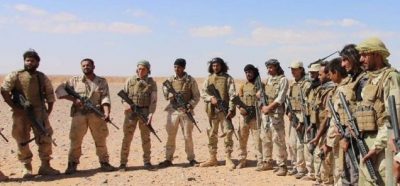Desertions in the Desert: US Mercenaries at Syrian Base Are Leaving

The last Syrian ‘rebel’ unit on the US payroll is dissolving by desertions. A former senior officer in the US-backed mercenary unit Maghaweir al-Thowra (MAT) deserted his unit in Syria on April 14. Samir Ghannam al-Khidr deserted the Eastern Syrian desert along with his whole family and 26 armed men. The convoy was subject to a video on social media, which showed 8 pickups, 1 truck, 11 small arms, including 5 M-16 rifles, 4 large-caliber machine guns, 5 grenade launchers and 6-7 thousand rounds of ammunition. All of the vehicles and weaponry were US military property. Al-Khidr left the illegal US base at Tanf, which is home to about 200 US soldiers, and about 100 mercenaries of MAT. Previous desertions occurred in early April.
The official Twitter account of MAT was busily posting scenarios in English. Their ‘spin-doctor’ belittled the deserter and made it seem that MAT allowed him to leave peacefully as if they packed him a lunch for the road.
Textbook level English
The MAT is made up of various Eastern Syrian tribes. English as a second language is taught beginning in 4th grade in all Syrian public schools, which are free of cost and are compulsory through the 9th grade. However, the level of English would be very basic, and anyone writing English texts on Twitter, for example, would be easily recognized as a novice in the English language.
However, the level of English used to explain and defend the MAT on their official Twitter account is of the highest level, comparable to an American, for example. Most likely, the account holder of the MAT Twitter account is not a member of the MAT, but rather a member of the US Special Forces. A US soldier was likely tasked with being the official public relations representative for MAT and sits at a laptop every day fielding complaints, accusations and commenting on charges against MAT in the news and social media.
Syrians use Arabic as their first language. When University educated Syrians, who have more than basic English language skills, were asked to review the Twitter account postings for MAT, they all could tell that was not written by any Eastern Syrian tribesman, carrying a machine gun, and looking like a ‘Hollywood-Double’ for ISIS. The members of MAT work for the US military, but they are not US-educated.
The illegal US base at Tanf
The US Army Special Forces have trained MAT at Tanf since 2016 to fight against ISIS, which was defeated in 2017. It would follow that MAT should have been disbanded several years ago, except the US could see a use for them as local guards of the small contingent of US soldiers. The MAT also was guarding the Baghdad-Damascus highway, which is a strategic trade route. Tanf is a US military base in Syria which is illegal under international law. There is no purpose for the base at Tanf except to thwart the free movement of goods and people on the Iraq-Syria highway.
Drugs, smuggling, and exploiting refugees
The recent deserter, Samir Ghannam al-Khidr, has been accused of being a drug dealer and smuggler between Jordan and the illegal US base at Tanf. He was accused last year of drug dealing and was detained but allowed to return to the US base at Tanf. This is not the first time drugs have made headlines in connection with the US Special Forces at Tanf. In June 2018, MAT was involved in a large drug bust at Tanf. The drugs were estimated to be valued at about $1.4 million. The unit captured more than 300,000 Captagon tablets. Captagon is classified as an “amphetamine-type stimulant” and has been used by ISIS as it keeps the fighters awake and has a mental effect of diminishing the conscience, allowing them to be vicious killers. Captagon is also the popular illicit drug throughout the Arab Gulf, such as Saudi Arabia and the United Arab Emirates.
MAT may have been introduced to the value of drug dealing in an area in Syria which has no government, or police supervision. The US base at Tanf is in a ‘no-man’s-land’ without any police, courts or judges. The Syrian government is not present there, and the US military likely turned a blind eye to the crimes being carried out by their mercenaries MAT.
The Rukban Refugee Camp is near the base at Tanf, and MAT has been used to provide security for the camp. Thousands of refugees have been living in squalor and suffering there; however, many have left the camp by paying bribes to MAT, to leave for the Syrian government-controlled city of Palmyra. Abu Muhammed recalled his ordeal at Rukban after leaving and told of how MAT would sell aid items that had been donated by international relief organizations.
“Sometimes, we received aid from the Red Crescent, but we only saw a small portion of it, most often sold to us, not given for free. The militants take the free aid and resell it to the refugees — that’s their business. To get money, we had to work at the camp. They set up a brick factory and we had to work like dogs there,” he said, and added, “They are all armed, they walk the camp with rifles, they have semi-military equipment and they own the place.”
*
Note to readers: please click the share buttons above or below. Forward this article to your email lists. Crosspost on your blog site, internet forums. etc.
This article was originally published on Mideast Discourse.
Steven Sahiounie is an award-winning journalist. He is a frequent contributor to Global Research.
Featured image is from Mideast Discourse

